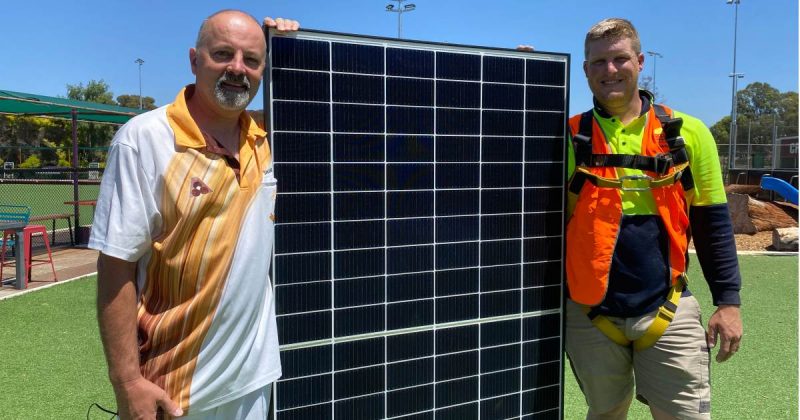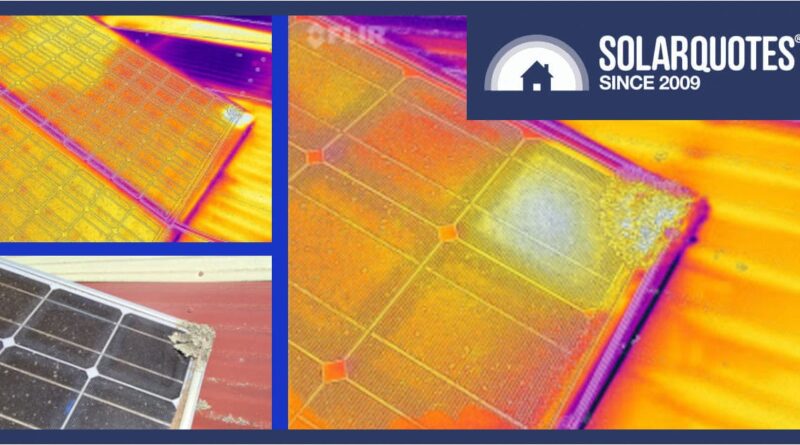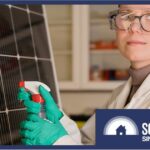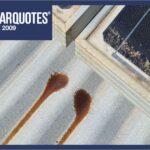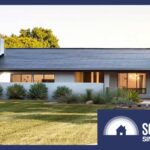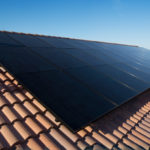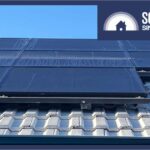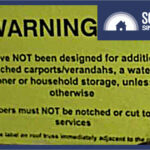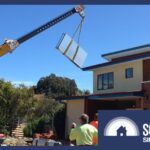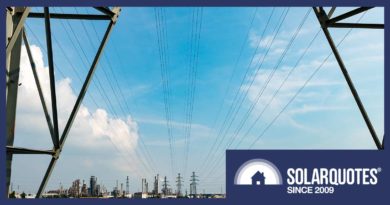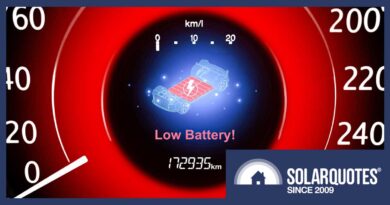Stop Hot Spots: Simple Solar Panel Maintenance Tips
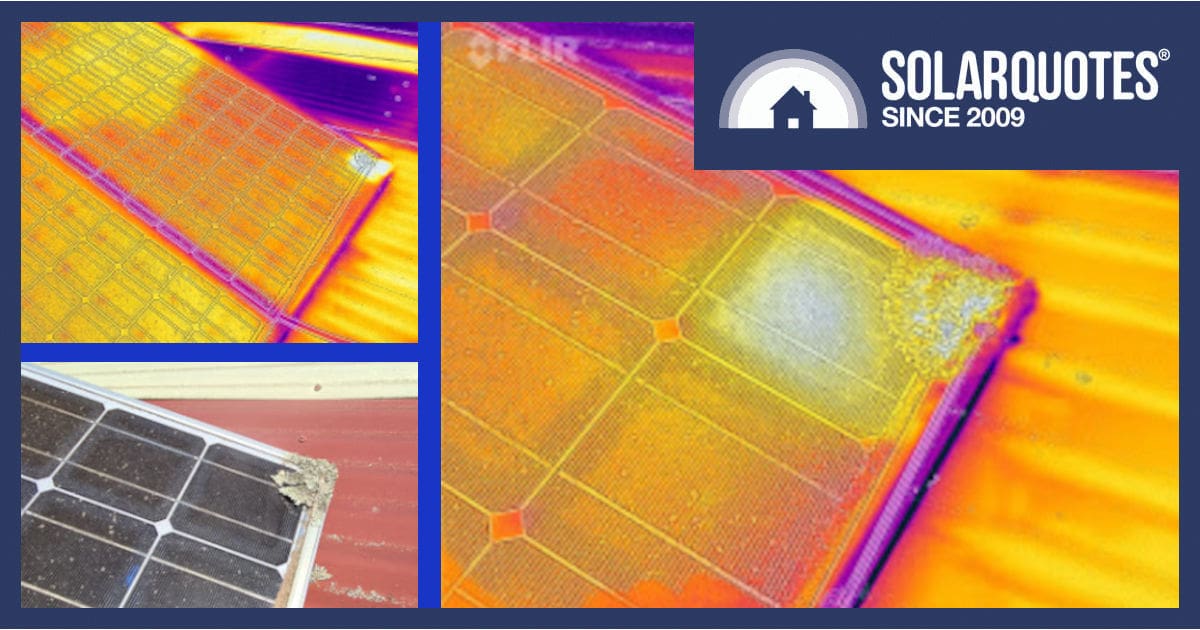
The whiter the image, the hotter the area.
Recently, I found myself back on the roof of a shed I hadn’t worked on for at least a dozen years. The solar hadn’t gone anywhere, but damn, it needed a clean.
These days I have a thermal camera to play with and a passing interest in how real world solar installs are coping with age. I’m happy to report this one was working well enough but the owner was wailing about a growing electricity bill. Owing to an annual rainfall of 800mm and an almost invisible installation, other things were growing unnoticed on the array.
It Was Quite A Trip
I was reminiscing in more ways than one. This was a roof I’d fallen through while helping erect the building in the first place. How? I committed my weight to stepping on a roof sheet that didn’t have any screws in it, which responded by standing up vertical, and allowing me to pass gracelessly through the frame.
“D’ya remember that!?” chuckled my old mate… Well yes; I’ll never forget landing on a screw gun, that hurt, but I particularly remember the laughter, and concern about denting the sheet of roofing iron. Hilarious it was.
Maintenance Time
This time around I was sucked into helping replace some cracked plastic skylight sheets, but we managed that work without any safety breaches.
While I was there I had a quick glance over the 3.33kW array. Originally consisting of 10 Sungrid branded panels, it was quickly expanded with 8 genuine Australian Made units from Silex.
Australia Was A World Leader In Solar
BP Solar used to run a complete solar panel manufacturing facility in Sydney, unlike Tindo Solar‘s current solar panel factory in Adelaide, it was a full end-to-end ingot, wafer, and panel operation.
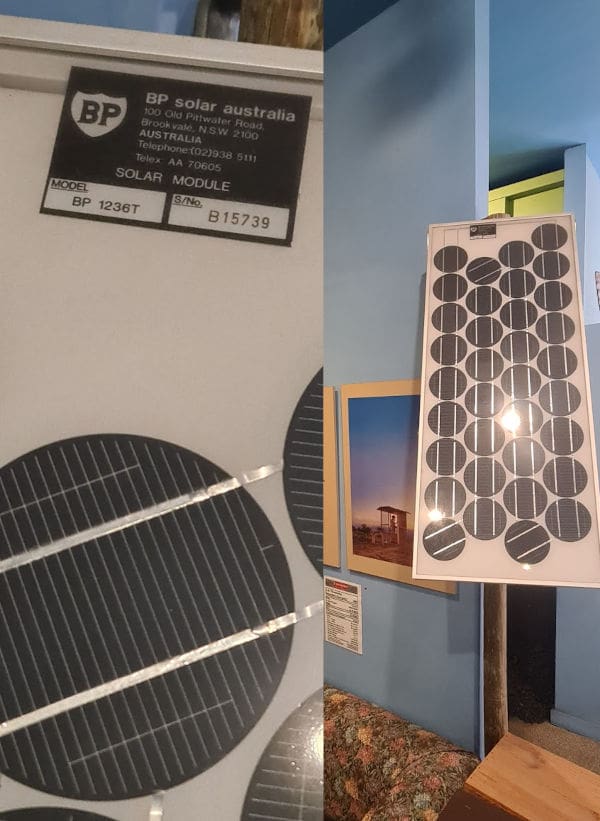
BP Solar Australia. It’s not just car manufacturing we’ve given up. This one is preserved in a museum in Port Augusta SA
It was the glory days when the new Sydney Olympic Village had Australian made panels on the roof, and our esteemed leaders spent ten times the research and development money on “clean coal1” than they did on renewables.
While BP used to supply panels for the iconic Telecom outback phone boxes, China had decided they should own the worldwide renewable industry. Our little plant soon became an uncompetitive tiddlywink in scale. After BP sold out, Silex took over for a while, but sadly it didn’t last.
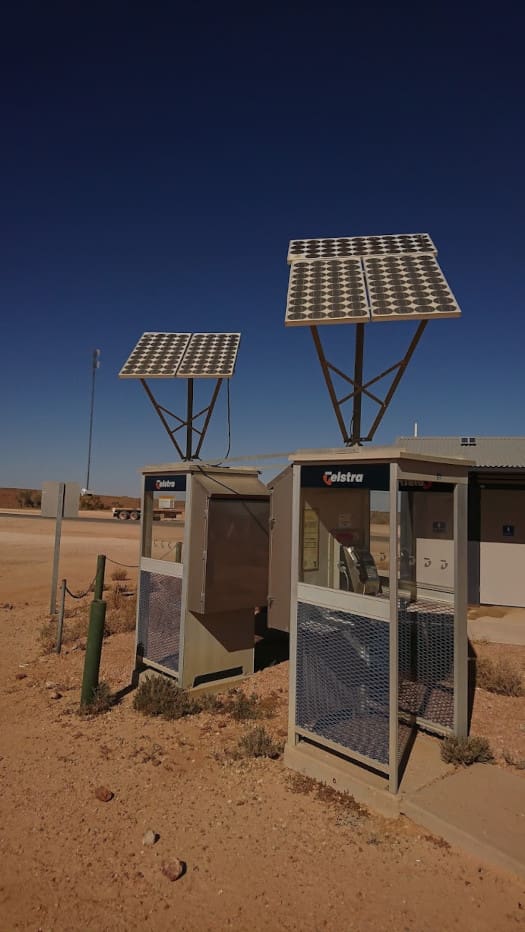
Telecom phone boxes at Innaminka. Image credit to Solar Depot for sending me there to see them
At least, today, we punch above our weight in terms of rooftop solar installation.
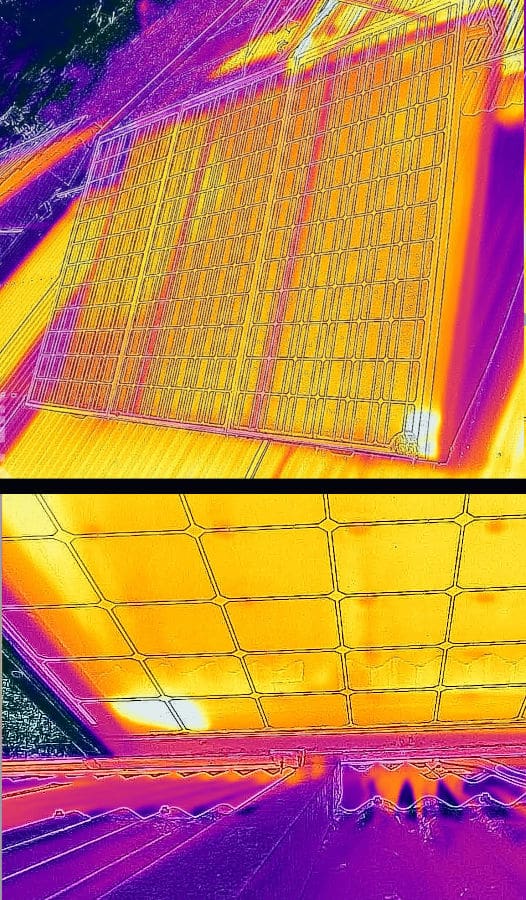
White = hot: viewed from the top or underneath, the panel from our cover image has a hot cell due to lichen growing across it
Hot Damn, There’s A Real Need For Cleaning
As the cover image shows, what looks like a fairly benign little patch of greenery really does affect the running temperature of a solar cell.
By blocking the light on this one cell, all of the others in this series have to force their electrons through an unproductive wafer.
For this example, a third of the panel will be affected, and the diodes in the junction box where the 3 strings of cells are connected will also be labouring to allow the rest of the panel to bypass the problem.
This excess heat is obviously wasted energy, but it will also shorten the cell’s life and damage overall output in the long term.
Happily, in this case, the cell didn’t take long to cool off once the offending growth was removed.
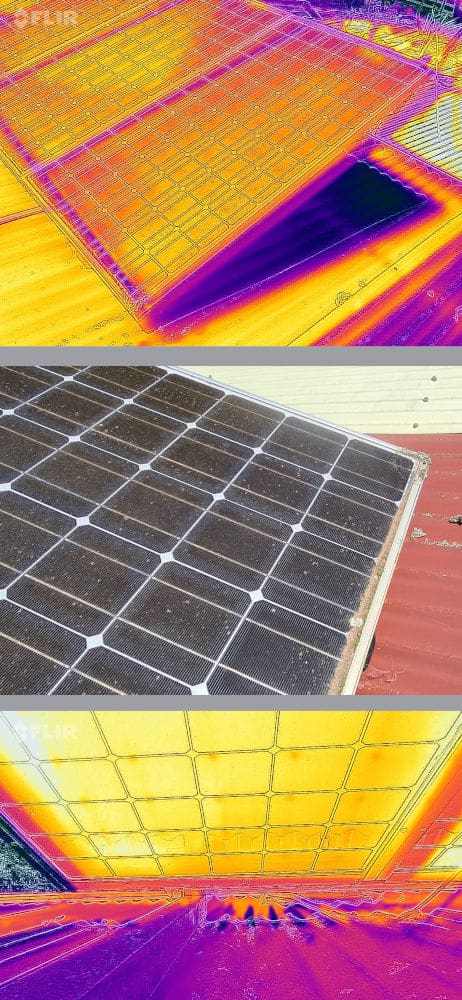
Simply scratching the bulk of the lichen off with my pocket knife was enough to make the difference.
Taking A Different View
Although these images are only taken with a basic $600 phone attachment2 the motivating impact they have on customers and installers is priceless.
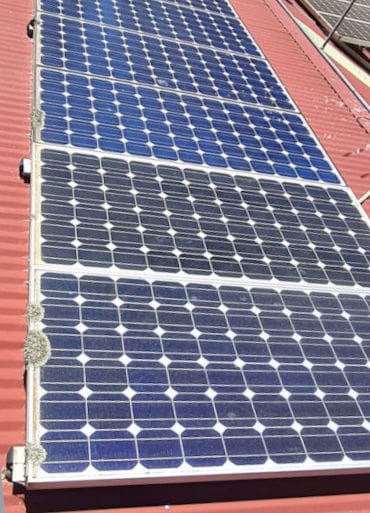
The lichen on this array looks pretty benign to the naked eye
Thermal cameras continually tune themselves to show contrast. In any given frame, there may be 10 degrees or 100 degrees difference in surface temperature.
The colours displayed don’t represent a particular number, but the coldest surface will be displayed as a dark patch, while the warmest is white hot, so to speak.
Better cameras put numbers on a scale to indicate actual temperature, but the latest software update seems to have removed that setting from my gadget.
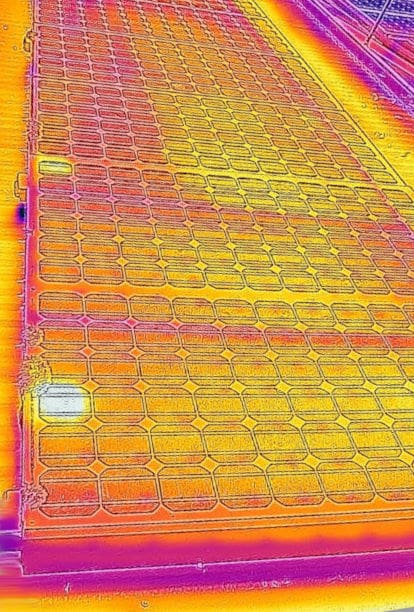
Here we see the same array with a couple of dogs’ bollocks on show; out of hundreds of cells; they really shine here.
For the best results, the sky is literally the limit. Commercial operators will outlay $15,000 or more on a high resolution camera and drone package.
Still, the expense is easily justified when you have thousands upon thousands of panels to inspect at a solar farm. And of course, drones are very handy for a domestic system on a difficult two story house.
Beware Of Solar Panel Cleaner’s Claims
When the dirt is so thick you can’t see the cells, cleaning is essential, however some solar panel cleaners are prone to exaggerating how much yield you can restore to a system simply by removing a transparent layer of grime.
If they have a photo of an inverter display showing 30% more power, it’s probably just because they’ve cooled the panels with water.
Provided the array has 10 degrees pitch or more, it’s likely to clean itself in the rain.
Under no circumstances should cleaning involve walking on the glass or using a pressure washing machine.
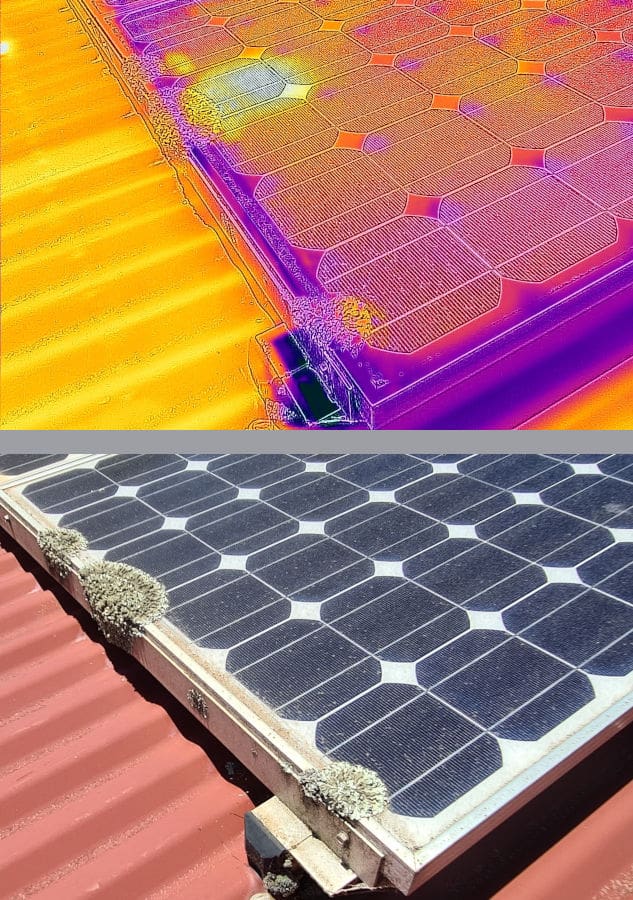
It’s interesting to see how little coverage causes a cell to heat up
5 Years Is Fine
My general advice is to engage a qualified solar company to clean and inspect your solar system as often as you like.
Remember though, as a small embedded generator, you’re obliged to have the system checked to ensure safety. The agreement you have with the poles and wires authority normally stipulates 5 year intervals but I’ve never heard of any audits being done.
Hard Shade Should Be Avoided
Though it may not look significant, the takeaway message here is simply that shadows are not good for solar cells. Whether it’s from bird droppings, leaves, and lichen, or worse still, from stink pipes, aerials, or other obstacles, the best output and longest life comes from eliminating hard-line shade.
Footnotes
- How good is clean coal though..? Reminds me of a famous passage by Donald Horne that nobody ever quotes in full. Australia is a lucky country run mainly by second rate people who share its luck. It lives on other people’s ideas, and, although its ordinary people are adaptable, most of its leaders (in all fields) so lack curiosity about the events that surround them that they are often taken by surprise.
- I’m sure there are half price knockoff thermal cameras by now
Original Source: https://www.solarquotes.com.au/blog/stop-hot-spots-solar-maintenance/


